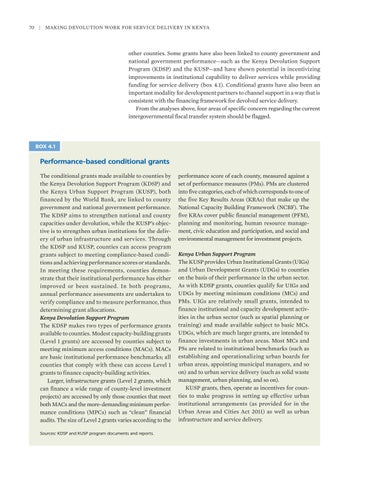70
|
Making Devolution Work for Service Delivery in Kenya
other counties. Some grants have also been linked to county government and national government performance—such as the Kenya Devolution Support Program (KDSP) and the KUSP—and have shown potential in incentivizing improvements in institutional capability to deliver services while providing funding for service delivery (box 4.1). Conditional grants have also been an important modality for development partners to channel support in a way that is consistent with the financing framework for devolved service delivery. From the analyses above, four areas of specific concern regarding the current intergovernmental fiscal transfer system should be flagged.
BOX 4.1
Performance-based conditional grants The conditional grants made available to counties by the Kenya Devolution Support Program (KDSP) and the Kenya Urban Support Program (KUSP), both financed by the World Bank, are linked to county government and national government performance. The KDSP aims to strengthen national and county capacities under devolution, while the KUSP’s objective is to strengthen urban institutions for the delivery of urban infrastructure and services. Through the KDSP and KUSP, counties can access program grants subject to meeting compliance-based conditions and achieving performance scores or standards. In meeting these requirements, counties demonstrate that their institutional performance has either improved or been sustained. In both programs, annual performance assessments are undertaken to verify compliance and to measure performance, thus determining grant allocations. Kenya Devolution Support Program The KDSP makes two types of performance grants available to counties. Modest capacity-building grants (Level 1 grants) are accessed by counties subject to meeting minimum access conditions (MACs). MACs are basic institutional performance benchmarks; all counties that comply with these can access Level 1 grants to finance capacity-building activities. Larger, infrastructure grants (Level 2 grants, which can finance a wide range of county-level investment projects) are accessed by only those counties that meet both MACs and the more-demanding minimum performance conditions (MPCs) such as “clean” financial audits. The size of Level 2 grants varies according to the Sources: KDSP and KUSP program documents and reports.
performance score of each county, measured against a set of performance measures (PMs). PMs are clustered into five categories, each of which corresponds to one of the five Key Results Areas (KRAs) that make up the National Capacity Building Framework (NCBF). The five KRAs cover public financial management (PFM), planning and monitoring, human resource management, civic education and participation, and social and environmental management for investment projects. Kenya Urban Support Program The KUSP provides Urban Institutional Grants (UIGs) and Urban Development Grants (UDGs) to counties on the basis of their performance in the urban sector. As with KDSP grants, counties qualify for UIGs and UDGs by meeting minimum conditions (MCs) and PMs. UIGs are relatively small grants, intended to finance institutional and capacity development activities in the urban sector (such as spatial planning or training) and made available subject to basic MCs. UDGs, which are much larger grants, are intended to finance investments in urban areas. Most MCs and PSs are related to institutional benchmarks (such as establishing and operationalizing urban boards for urban areas, appointing municipal managers, and so on) and to urban service delivery (such as solid waste management, urban planning, and so on). KUSP grants, then, operate as incentives for counties to make progress in setting up effective urban institutional arrangements (as provided for in the Urban Areas and Cities Act 2011) as well as urban infrastructure and service delivery.


